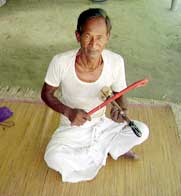
|
The Pena (a.k.a Bana, Bena, or Tingtelia) is a bowed lute found
in North East India and Bangladesh. It is used in folk music as well
as the accompaniment of the Manipuri dance styles. It is part of a
culture of bowed instruments which extends throughout north India.
As such, the pena is remarkably similar to the ravanhasta found in
Maharashtra, Gujarat, and Rajasthan, and the ubo found in Manipur
and Nagaland, or the kenda found among the Munda (Mundari) of
Northern India and Bangladesh. dance styles. It is part of a
culture of bowed instruments which extends throughout north India.
As such, the pena is remarkably similar to the ravanhasta found in
Maharashtra, Gujarat, and Rajasthan, and the ubo found in Manipur
and Nagaland, or the kenda found among the Munda (Mundari) of
Northern India and Bangladesh.The subject of terminology is always problematic when dealing with Indian music. In this page, some terms will be from Manipuri while others may reflect a rustic Bengali dialect. However, we cannot even begin to fathom the various alternative terminology that may be found in the different tribal communities of North East India and Bangladesh. These considerations should be kept in mind. There is a considerable variation in the name of this instrument. In Manipur, it is usually known as pena, but the Nagas often refer to this as tingtalia. In Bangladesh it is known as bana or bena. It is possible that this instrument may be linked to the pinaki vina, mentioned in numerous ancient texts. However, there is the strong likelihood that bana or bena is merely a corruption of the Bengali term bina, which in turn is a corruption of the Sanskrit word vina. The names of this instrument imply a certain generic quality; this is indicated by the fact that the be-ana of West Bengal is of a different construction, yet still played with a bow. The social significance of this instrument is varied. In Manipur, the pena has a rich tradition. At one time, this instrument was played in royal courts and was considered part of the "high culture" of the region. Today, it is usually associated with folk music and the traditional Manipuri dance. It is still occasionally used for funerals and weddings. The bana of Bangladesh is used in folk music, and is found in folk theatre.
The instrument consists of two basic parts. There is the body of the instrument and there is the bow. The body of the instrument is known as penamasa in Manipur, or dhorr in Bangladesh. The bow has different names. In Manipur it is known as "pena cheijing", while in Bangladesh it is known as chorr.
The main body of the instrument is made by taking a length of bamboo and passing it through a half coconut shell. This forms the neck of the instrument; it is sometimes referred to in Bangladesh as the noli. This bamboo is roughly 10-11 inches in length and roughly 1 to 1.25 inches in diameter. It it is trimmed at the base and then passes through two holes cut in the half coconut shell. Aside from the holes in which the bamboo passes there are two holes for acoustical purposes. The largest opening is covered with some type of skin or membrane. There is also a smaller sound hole cut into the back; this smaller sound hole remains open.
There is a decorative scroll attached to the end of the instrument. In Bangladesh, this is known as mogra.
There is also a tuning peg used to control the tension on the
string. This is fitted into two holes made in the side of the bamboo
neck. In Bangladesh, this pegs is known as kaan; it too is made from
bamboo. |
||